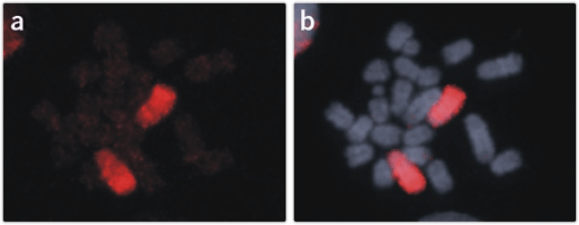Chromosome Painting
Chromosome coloring is a powerful technique that can be used to study the topological structure of chromosomes at any stage of the cell cycle without nucleus fragmentation. The preservation of cell nucleus morphology is essential for understanding the interactions and dynamics between chromosomes in the cell nucleus during the cell cycle. More and more studies support the importance of chromosome structure during development. The conventional banding method for chromosome identification is invasive and can only be applied to mitotic cells. FISH technology makes up for the lack of spatial information needed to solve the natural chromosomal organization in the follow-up analysis of metaphase proliferation. Whole chromosome probes are differentially labeled and are specific for non-repetitive sequences, so they can identify every chromosome in the cell. This information can then be used to assess the chromosome identity and relative position in many different cell types.
FISH Services and Chromosome Painting
The purpose of chromosome drawing is to use the whole chromosome multicolor probe set or obtain a whole chromosome map. This service can visualize chromosomes for different biological samples and is widely used in cytogenetics. The chromosome coloring probe used in this service is composed of a hybrid combination of DNA-FISH probes combined with the non-repetitive sequence of a single chromosome. We provide services that use whole chromosome paint to study the organization of chromosomes without damaging the nucleus. It also provides services for the comparison of the whole genome of the chromosome composition of different species for research in the field of comparative genomics. Through this service, the position of chromosomes can be analyzed and the translocation and ploidy in the nucleus can be identified.
 Fig 1. Example of cross-species chromosome painting. (Rens W, et al. 2006)
Fig 1. Example of cross-species chromosome painting. (Rens W, et al. 2006)
Service Options
These chromosome painting services are aimed at cell karyotype analysis, discovery and location of some non-random chromosome folding, comparative genomics research, identification of chromosome position in the nucleus, chromosome translocation and ploidy changes, and so on. Our chromosome painting service provides karyotype and chromosome analysis for a single species, as well as comparison chromosome painting services for two species.
The main process of our chromosome painting service includes experimental plan and probe design, plan confirmation and probe preparation, optional chromosome preparation, FISH hybridization, microscope service and data service. This service can process nuclear tissue samples, you only need to send the samples to the laboratory (note the sample preservation). In addition, we also provide comparison chromosome painting services.
- Comparative Chromosome Painting
Cross-species chromosome painting is a powerful procedure for genome-wide comparison of the chromosome composition of different species, and is also called chromosome in situ suppression (CISS). This technique can identify ancient syntenies shared by widely different species and clearly define chromosomal rearrangements between species. Different fields of comparative genomics benefit from this analysis. Chromosome painting accelerates the study of karyotype evolution, by comparing the complementation of chromosomes of several related species (including one or more outgroup species), determining chromosomal rearrangements, and establishing a putative ancestral karyotype. For example, genetic research uses comparative cytogenetic maps between poorly mapped model species and densely mapped humans or mice to locate genes of interest in poorly mapped species. The main processes of this service include cell culture, metaphase chromosome preparation, chromosome-specific DNA labeling, fluorescence in situ hybridization (chromosome staining), microscope services, and image analysis.
 Fig 2. Comparison of chromosome painting and comparative chromosome painting.
Fig 2. Comparison of chromosome painting and comparative chromosome painting.
Creative Bioarray provides a variety of chromosome painting service options to help our customers carry out relevant research. You will benefit from our technical expertise and complete experimental equipment. Within 5-15 days of service, we will update the service progress at any time. If you are interested in our various chromosome painting services, please contact us for cooperation. We look forward to cooperating with you in the near future.
References
- Rens W, Fu B, O'brien P C M, et al. Cross-species chromosome painting[J]. Nature protocols, 2006, 1(2): 783-790.
- Liyanage M, Coleman A, du Manoir S, et al. Multicolour spectral karyotyping of mouse chromosomes[J]. Nature genetics, 1996, 14(3): 312-315.
- Hua L L, Mikawa T. Chromosome painting of mouse chromosomes[J]. Methods in molecular biology (Clifton, NJ), 2018, 1752: 133.


 Fig 1. Example of cross-species chromosome painting. (Rens W, et al. 2006)
Fig 1. Example of cross-species chromosome painting. (Rens W, et al. 2006) Fig 2. Comparison of chromosome painting and comparative chromosome painting.
Fig 2. Comparison of chromosome painting and comparative chromosome painting.


